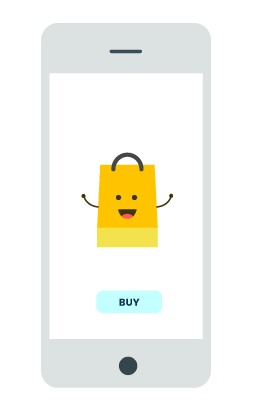What is m-commerce?
There is no m-commerce definition as such but we can interpret as “the action of buying and selling of products through various communication medium such as mobiles/wireless technologies and devices”.
A user who purchases on Websites or apps or performs activities like paying for travel, events or bills; or redeeming a coupon. Any type of commerce that is carried out using a mobile device is called m-commerce.

But there are much broader definitions of m-commerce that include all types of mobile transactions, such as mobile banking (m-banking) and money transfers.
M-commerce is not an “if you build it, they’re going to come” scenario. The design and functionality of apps also are critically vital to driving conversions and retention. Gone are the times where you may convert an RSS feed of your catalog data into a mobile-optimized web content and insert it into an app wrapper.
Consumers currently expect extremely refined app experiences, which implies that brands ought to invest more in their apps and collect and connect complex data types to enable them.
Why you should go for m-commerce?
In 2010, m-commerce traffic constituted only 5.2% of total online shopping traffic, while in 2015 that percentage increased to over half of all online shopping traffic. Similarly, mobile sales comprised only about 5% of online sales in 2010, but by 2015 that number increased to more than 31%.
Business Insider forecasts that mobile sales will continue to rise, comprising 45% of the $632 billion in total e-commerce sales by 2020.

Independent analyst Forrester analysis finds that people like mobile apps over the mobile web due to the speed and convenience apps offer. Retailers have smart reason to prefer apps too, as studies reveal that apps are more effective than websites at converting traffic into sales.
performance marketing expert Criteo reports that people view nearly four times as many products in apps as they do on mobile websites, with app conversion rates 120% higher than mobile net conversion rates.
Some reasons to opt m-commerce
- Your customers will use your mobile app for online shopping whenever needed.
- As the mobile apps are user-friendly, it’s very convenient for customers to use.
- The benefits of mobile apps are even bigger when you commit to developing a customized mobile app with a lot of flexibility and options supported business needs.
- With a mobile app, you’ll be able to gift your product and services in a better approach.
M-commerce advantages and disadvantages
Advantages
- The mobile device is currently everywhere and has much wider attain than computers. Consequently, it’s easier for customers to use m-Commerce applications to carry out transactions.
- With growing competitors, there are great chances that customers obtain better deals on mobile commerce sites.
- Buyers can have look thousands of items on their cell phones and there is no need for the online checkout process.
Disadvantages
- Poor internet connectivity and sluggish speed are one of the purposes that tends to create the entire item purchase & payment method a hassle for a client.
- Developing a mobile commerce software is more expensive.
- Mobile device constitutes a small display in comparison to laptops & personal computers, which does not give a very great buying experience to buyers.
Will mobile-commerce replace e-commerce?
According to a Marketingland report, nearly 55% of all web traffic that streams into the top sites comes from smartphone handsets. But is m-commerce really this much of a game changer for ecommerce as a whole? The short answer is: Yes.
Mobile shopping stats
- Over 59% of smartphone users research products from their handset before making an online purchase.
- Over 50% of smartphone shoppers say they will rely on a digital wallet to make purchases this year.
- 75% of mobile shoppers redeemed coupons when shopping over the past three years.
- 84% of mobile shoppers rely on smartphones to help them when making a purchase at a brick and mortar store

Infographic by – Fme Addons
Factors to consider while building m-commerce applications
Some prerequisites ought to be pondered upon, which might facilitate to maximize the App expertise for all the users. This helps in increasing the sales volume, leading to higher conversion rates for the intended retail merchant.
Choose your platform
There are several mobile platforms you’ll be able to use and choosing the proper ones is the first step to form your plan. The foremost common are iOS and Android but there are several smaller platforms that may give interesting niche audience for your specific wants.
You should start with defining your target market and find what operating system they use. iOS and Android have the biggest user base and you’ll most likely find most of your target audience on one among them or both.
Select the right technology
You’ll be able to use many alternative technologies for mobile app development and range of platforms is one of the factors to make your selection.
You have got two main choices – HTML5 (hybrid) or native apps. It’s continuously about meeting your budget and deadlines, therefore, compare each solution and realize the one that works for you.
Design

Any retail App must show a list of products/catalog, with list of pictures and also the real question is how to retrieve data in the right manner from the backend servers, while not compromising the user expertise. Design is the one thing a user looks when he enters the application.
Usability

For any user, this is the main driving force to download the App and to start using it. Build customer centric product. This aids the navigation and makes an App useful and beneficial, which further helps in promoting business.
Some tips for better usability
- Personalization, that helps in faster App interactions
- Quality of images of product and effective navigation throughout the App
- Well-structured data entry
- Control for product sizes and similar choices
Social media integration

The frequency of using social media like Facebook to see your friend’s purchases, sharing the product details and therefore the ability to feature comments, would trigger a lot of downloads.
Linking the App from a mobile website, for optimum expertise and promotions, through social networks based on purchase history.
Performance and speed

The performance criteria merit a special mention in developing a retail App, because it builds the expertise and therefore the merchandiser revenue. The crucial side is that the speed and performance. Quicker the response, the higher an App performs.
Notifications and recommendations

Any retail app user would get benefits if helpful recommendations are provided and notification of newly launched product or product offers would be beneficial.
Once a messaging/notification system is used to attract the particular user group, App would certainly create a good impact.
These are some of the m-commerce features to consider recently, and recognizing what’s necessary for your specific business is that the key to implementing an efficient solution.
M-commerce strategies to Drive Mobile Commerce Growth & Retention

Improve the app experience
It’s time to think about the particular functionality of your mobile-commerce app. What special m-commerce features do you need? You’ll be able to always find inspiration in your competitor’s apps.
You can enhance the shopping experience through better navigability, design and provide simple and easy interface.
Your app should adapt to provide better user experience by offering unique features such as real-time offers or promotions, barcode scanners, saved shopping lists, and more.
For example, Starbucks introduced a mobile payment solution that allows customers to pay for items by having the barcode on selected smartphone models scanned at the POS.
Use in-app messages for better engagement

In-app messaging may be a helpful way to interact customers and encourage a dealing while they’re actively using your app.
App inbox offers several advantages, including the ability to deliver rich, full-page content in a variety of formats and extend the reach of that content.
In-app messages don’t disappear after being viewed like push notifications do, inbox messages are significantly helpful for ongoing promotions and for long-form, media-rich content.
Provide better Service and Support

Since many users are new to mobile commerce applications it is necessary to provide service and support. This can be converted into positive experiences and increase the retention rate.
Marketing strategy

Your m-commerce strategy should be an important part of your marketing strategy and not just an extension of it. Think of mobile advertising, geo-targeting, location-based services, coupons, mobile value-added options, use case primarily based style, mobile email marketing.
Immediately after waking up, about 62% of mobile users check their devices. Mobile has been considered as an integral part of everyone. All online sellers and marketers find new ways to incorporate mobile into the overall marketing strategies.
If you would like to know more about how to build an m-commerce application, contact us to discuss this further with our team.